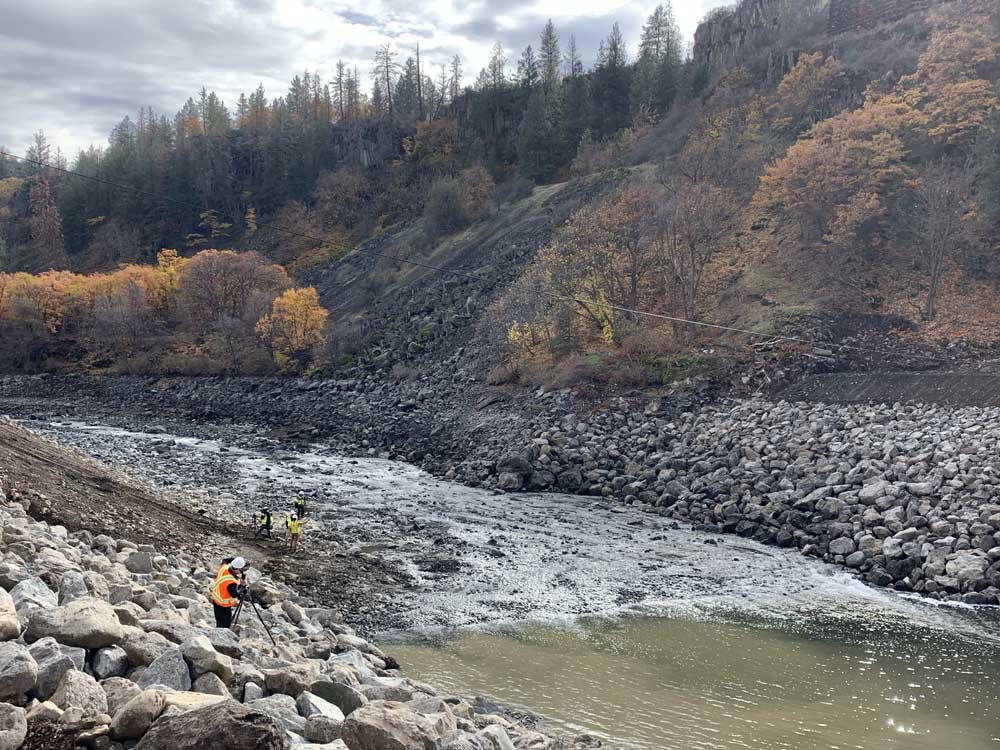‘It’s all about salmon’: Klamath River’s nearly century-old Copco 2 dam is history
Published 6:00 am Tuesday, November 14, 2023

- The site of the Copco 2 dam, shown here last week when journalists visited, is now just a quiet section of the Klamath River. The dam, east of Hornbrook, California, was removed earlier this year, the first of four dams to be taken down in an effort to improve fish passage and river health.
HORNBROOK, California — For nearly 100 years, Copco 2 was one of the dams along the Klamath River, but now it’s no more.
Completed in 1925, Copco 2 was located just below Copco 1 in a steep canyon upstream from the small Northern California community of Hornbrook and about a hour’s drive from Ashland. It is the first of four dams to be removed.
What used to a 33-foot-high diversion dam is now a section of a river being restored to its historic, free-flowing state.
During a tour of the former Copco 2 dam site last week, a small group of journalists were guided by Ren Brownell, public information officer for the Klamath River Renewal Corporation, which is overseeing the removal of the dams. Bromwell said Copco 2 was selected as the first dam for removal because of its “small stature, lack of reservoir and because it would have been in the way of the drawdown process at Copco 1.”
Work on removing Copco 2’s structure was completed in September, but it took another month to remove the remaining diversion infrastructure, grade the river channel and do erosion control.
Mark Bransom, CEO of the renewal corporation, said Copco 2 was selected as the first to go because of its small stature, location and lack of reservoir.
“However, while Copco No. 2 was significantly smaller than the other dams slated for removal, it still had a significant impact on the river,” he said.
Copco 2 was located in an area known to the Shasta Indian Nation as Kikacéki and commonly known as Wards Canyon, a name honoring Kitty Ward, a Shasta woman who lived there. The dam funneled river into a tunnel that sent the water to a downstream powerhouse.
Brownell said the process essentially de-watered a 1.7-mile-long section of the canyon, allowing trees to then grow in the riverbed, but they would have died when exposed to consistent water flows. Because dead trees would have created hazards for future recreational users — including rafters, kayakers and boat-based anglers — they were removed earlier this year.
At the request of the state of California, the Copco 2 powerhouse and other facilities will mostly remain in place and eventually be used as a visitor interpretive center.
The three remaining dams — Copco 1, Iron Gate, and J.C. Boyle — will be removed next year, with the slow draining of the reservoirs scheduled to begin on Jan. 4. The process, known as drawdown, is expected to last until April or as late as June, depending on spring runoff. Once the drawdown is complete, restoration and deconstruction activities will significantly increase. All three dams are expected to be completely removed by November 2024.
Overall, the dam removals will expose about 2,200 acres of reservoir beds that will be restored over a multi-year process. Upwards of 17 billion seeds have been collected and will be planted.
The tour also provided a glimpse of the work that’s currently being done and planned at the 180-foot-tall Iron Gate Dam, which is located downstream from the other three dams. Planning and early steps in deconstruction and restoration began several years ago. The Iron Gate fish hatchery is being relocated to nearby Fall River.
Brownell said the primary goal of the dam removals is to restore fish passage and improve water quality.
“It’s all about salmon,” she said. “We do expect fish will make it upstream pretty quickly.”
Planning has included consultation with tribes, including the Yurok, Shasta and Klamath tribes, which had villages along the river and relied on fish as a major food source.
Before the dams were built, the river supported upwards of a million spring and fall Chinook salmon, along with large populations of steelhead trout, Pacific lamprey and other native fish species, according to estimates. Fisheries biologists believe the dams are by far the single biggest impediment to fish production. They expect fish populations to gradually increase because of renewed access to historic spawning areas, a reduction in disease exposure and improved ecosystem health.
The estimated cost of the dam removal and restoration is $450 million, with a $50 million contingency fund. The cost is funded through a $200 million surcharge on PacifiCorp and $250 million in bonds from the state of California.
Editor’s note: This story has been updated to clarify why Copco 2 was chosen as the first dam for removal.






